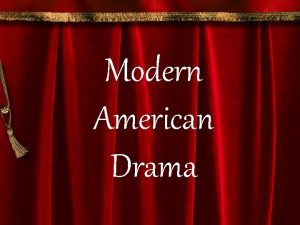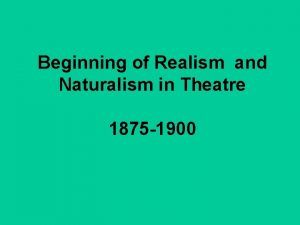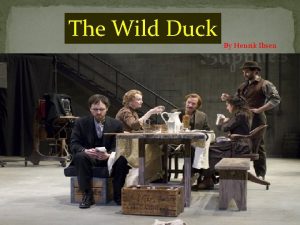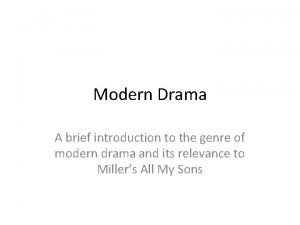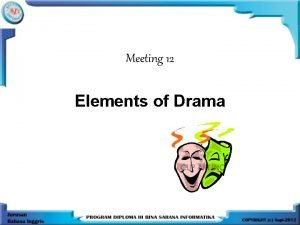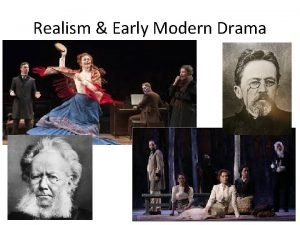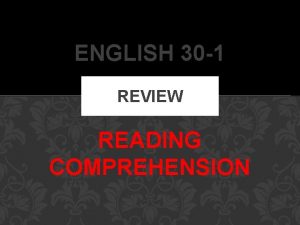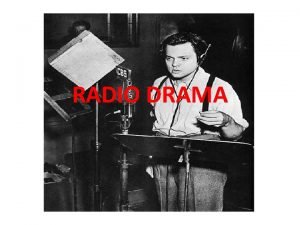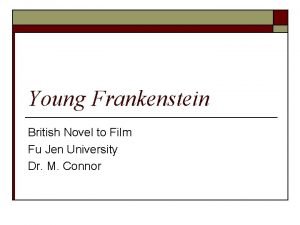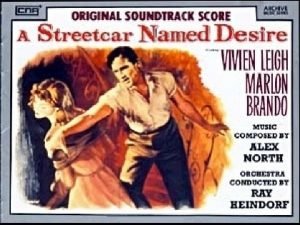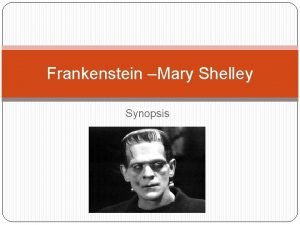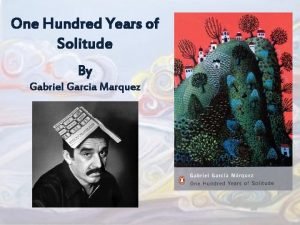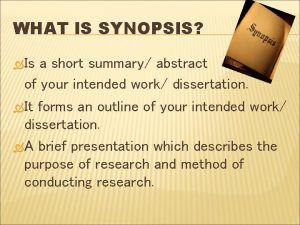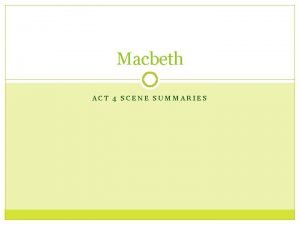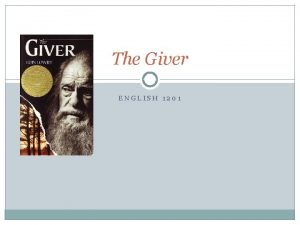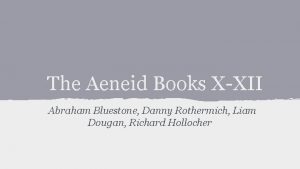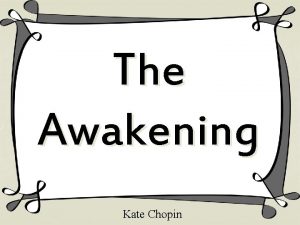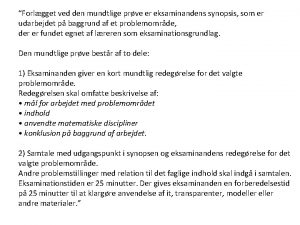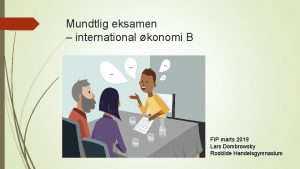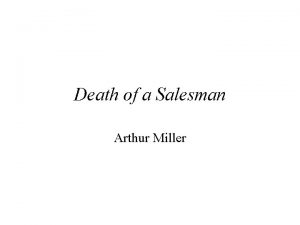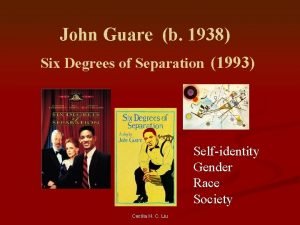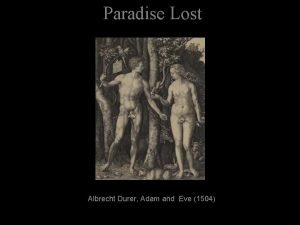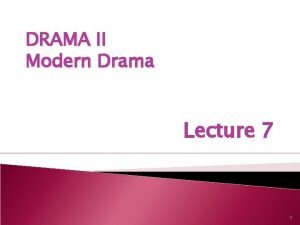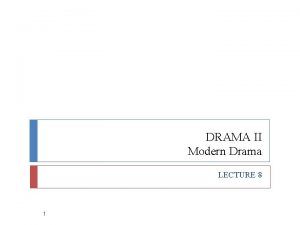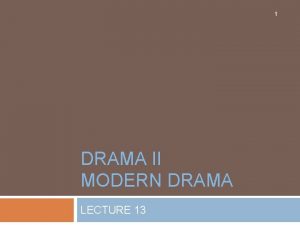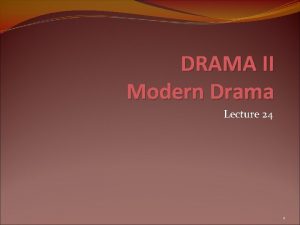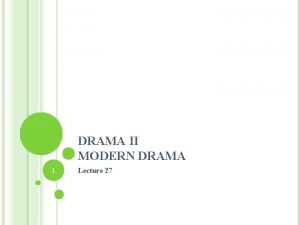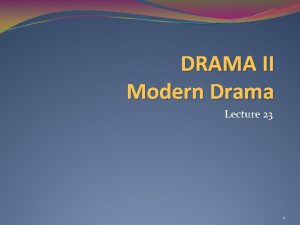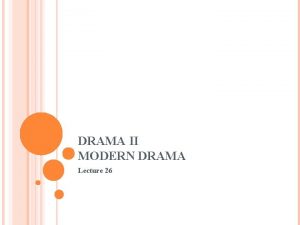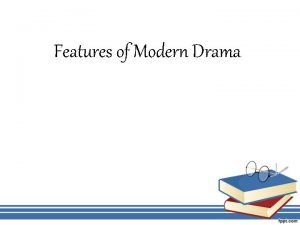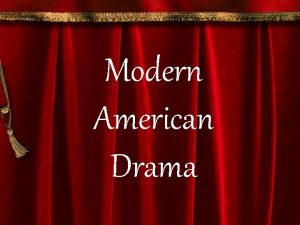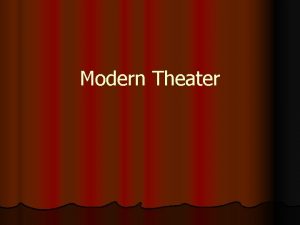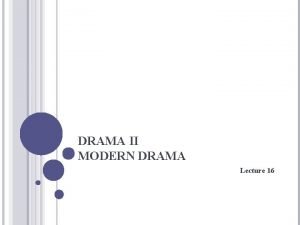1 DRAMA II MODERN DRAMA Lecture 21 SYNOPSIS






































































- Slides: 70

1 DRAMA II MODERN DRAMA Lecture 21

SYNOPSIS 2 1. 2. 3. 4. 5. 6. 7. 8. A Conclusive Talk George Bernard Shaw The Myth Behind the Play Contextual Background George Bernard Shaw’s Philosophy Plot Overview Characters, Role, Relationship, Conflicts & Significance Themes and the major Conflicts

3 George Bernard Shaw PYGMALION

4 A Conclusive Talk Waiting for Godot Lecture 14 Waiting for Godot By Samuel Beckett 3. Samuel Beckett’s Biography An Overview of Waiting for Godot 4. Characters in the Play Setting of the Play Beckett’s Theatrical Concept and Style

5 A Conclusive Talk Waiting for Godot Lecture 15 SUMMARY: Waiting for Godot 2. Summary and Analysis Act I: Introduction & Pozzo and Lucky's Entrance Act II: Introduction & Pozzo and Lucky's Entrance 3. Discussion Questions / Aspects to be analyzed

6 A Conclusive Talk Waiting for Godot Lecture 16 SUMMARY: Waiting for Godot (Conti…) 2. Summary and Analysis Act I: Introduction & Pozzo and Lucky's Entrance Act II: Introduction & Pozzo and Lucky's Entrance 3. Discussion Questions / Aspects to be analyzed

7 A Conclusive Talk Waiting for Godot Lecture 17 Absurdist Drama Dialogue and Language/Humor of Absurdist Drama Plot & Structure of Absurdist Drama THEMES in Waiting for Godot Aspects to Consider

8 A Conclusive Talk Waiting for Godot Lecture 18 1. 2. 3. 4. 5. Waiting for Godot Symbolism, Imagery & Allegory Setting Waiting for Godot Genre, TONE, STYLE & Title Waiting for Godot as Booker’s Seven Basic Plots Analysis: Tragedy Plot Social Acceptance of Waiting for Godot Critical Analysis

9 A Conclusive Talk Waiting for Godot Lecture 19 An Introduction to 1. Philosophical Background of Waiting for Godot Theatre of Absurd Existentialism The Paradox of Consciousness 2. Becket: Critical Analysis (Analytical Mapping) Characters

10 A Conclusive Talk Waiting for Godot Lecture 20. Analytical Mapping: Social Significance 2. Philosophical Background: Themes A. Social B. Psychological C. Religious 3. Dramatic references: Themes

George Bernard Shaw 11 George Bernard Shaw (18561950) was the third and youngest child (and only son) of George Carr Shaw and Lucinda Elizabeth Gurly Shaw. Technically, he belonged to the Protestant “ascendancy”—the landed Irish gentry—but his impractical father was first a sinecured civil servant and then an unsuccessful grain merchant

George Bernard Shaw 12 George Bernard grew up in an atmosphere of genteel poverty, which to him was more humiliating than being merely poor

George Bernard Shaw 13 Another historical point that may have some importance is that in 1872 his mother left her husband took her two daughters to London, following her music teacher, George John Vandeleur Lee, who from 1866 had shared households in Dublin with the Shaws. Whatever we may feel about this, it shows him close to an exceptionally independent woman

George Bernard Shaw 14 In 1876 Shaw resolved to become a writer, and he joined his mother and elder sister (the younger one having died) in London. Shaw in his 20 s suffered continuous frustration and poverty. He depended upon his mother's pound a week from her husband her earnings as a music teacher.

George Bernard Shaw 15 He spent his afternoons in the British Museum reading room, writing novels and reading what he had missed at school, and his evenings in search of additional self education in the lectures and debates that characterized contemporary middle-class London intellectual activities. His fiction failed utterly. The semiautobiographical and aptly titled Immaturity (1879; published 1930) repelled every publisher in London.

George Bernard Shaw 16 His next four novels were similarly refused, as were most of the articles he submitted to the press for a decade. Shaw's initial literary work earned him less than 10 shillings a year. A fragment posthumously published as An Unfinished Novel in 1958 (but written 1887– 88) was his final false start in fiction. Despite his failure as a novelist in the 1880 s, Shaw found himself during this decade. He became a vegetarian, a socialist, a spellbinding orator, a polemicist, and tentatively a playwright

George Bernard Shaw 17 Before long, Shaw had become one of the most sought-after public speakers in England. He argued in his pamphlets in favor of equality of income and advocated the equitable division of land capital. He believed that property was "theft" and felt, like Karl Marx, that capitalism was deeply flawed and was unlikely to last. Unlike Marx, however, Shaw favored gradual reform over revolution. And there we see Alfred Doolittle, common dustman.

George Bernard Shaw 18 In one pamphlet written in 1897, he predicted that socialism "will come by prosaic installments of public regulation and public administration enacted by ordinary parliaments, vestries, municipalities, parish councils, school boards, etc. "

George Bernard Shaw 19 In 1892, Shaw wrote his first play, Widowers' Houses, about the evils of slumlords. The play was attacked savagely by people who opposed his politics. It was then that Shaw knew he was a good playwright--he must have been to have upset so many people with his social commentary. He went on to revolutionize the English theater by concentrating his writing on various social issues at a time when most other playwrights were writing "sentimental pap. "

20 The Myth Behind the Play PYGMALION

The Myth Behind the Play 21 There is never any overt reference in the play to Pygmalion; Shaw assumes a classical understanding. According to the Mythology Guide “Pygmalion saw so much to blame in women that he came at last to abhor the relation with them, and resolved to live unmarried. He was a sculptor, and had made with wonderful skill a statue of ivory, so beautiful that no living woman could be compared to it in beauty. It was indeed the perfect sem-blance of a maiden that seemed to be alive, and only prevented from moving by modesty. His art was so perfect that it concealed itself, and its product looked like the workmanship of nature.

The Myth Behind the Play 22 Pygmalion admired his own work, and at last fell in love with the counter-feit creation. Oftentimes he laid his hand upon it, as if to assure himself whether it were living or not, and could not even then believe that it was only ivory. The festival of Venus was at hand, a festival celebrated with great pomp at Cyprus. Victims were offered, the altars smoked, and the odor of incense filled the air. When Pygmalion had performed his part in the solemnities, he stood before the altar and timidly said, "Ye gods, who can do all things, give me, I pray you, for my wife" he dared not say "my ivory virgin, " but said instead "one like my ivory virgin. " Venus, who was present at the festival, heard him

The Myth Behind the Play 23 While he stands astonished and glad, though doubting, and fears he may be mistaken, again and again with a lover's ardor he touches the object of his hopes. It was indeed alive! The veins when pressed yielded to the finger and then resumed their roundness. Then at last the votary of Venus found words to thank the goddess, and pressed his lips upon lips as real as his own.

The Play Itself: PYGMALION 24 One of the most popular plays of Bernard Shaw, first performed in 1913 in Vienna and published and performed in London in 1916.

Is it a Romance? 25 Shaw says “NO!” The Text says “Yes!”

26 Contextual Background PYGMALION

Pygmalion: Background 27 Pygmalion is set in London, England, around the beginning of the twentieth century.

Pygmalion: Background 28 During this time in London, working-class people like Eliza Doolittle • lived in slums • had no heat or hot water • had to put coins in a meter to get electric light

Pygmalion: Background 29 The class structure in England at this time was very rigid. upper class middle class working class

Pygmalion: Background 30 The government did provide some schooling. However, an education did not teach the proper speech that was considered a sign of the upper class.

Pygmalion: Background 31 The way that many working-class people spoke was an obstacle to their becoming middle class.

Pygmalion: Background 32 In Greek mythology, Pygmalion was a gifted, young sculptor who resolved never to marry.

Pygmalion: Background 33 But after Pygmalion created a statue of a beautiful woman, he fell in love with the statue. Miserable because he loved a lifeless object, he appealed to Aphrodite, the goddess of love.

Pygmalion: Background 34 Sympathetic to the young artist’s plight, Aphrodite turned the statue into a live woman. Pygmalion named the beautiful maiden Galatea, and the two were married.

35 George Bernard Shaw’s Philosophy PYGMALION

George Bernard Shaw 36 “I must warn my readers that my attacks are directed against themselves, not against my stage figures. ” -Shaw

George Bernard Shaw 37 • • Shaw wanted to force his viewers to face the reality of unpleasant events. He promoted the “unpleasant” plays by publishing a long preface in which he could argue his views. Shaw was awarded the Nobel Prize for literature in 1925. He continued to write until he was 94.

In turn, this affects how others behave towards us. 38 Likewise, how we behave impacts what people think about us. What we believe influences how we behave Ultimately, how they behave towards us reinforces what we believed about ourselves in the first place http: //www. meghanwilliams. com/ugb. html

39 Plot Overview PYGMALION

Pygmalion: Introduction 40 In this play, George Bernard Shaw uses humor and lively characterization to explore how language, class structure, education, and gender influence how people are seen by society.

Pygmalion: Introduction 41 The two main characters are • Eliza Doolittle—a poor but proud flower girl with a cockney accent— a way of speaking associated with the working classes. • Henry Higgins—an arrogant and insensitive linguistics professor

Pygmalion: Introduction 42 Eliza comes to Higgins’s house to ask him to give her speech lessons. She wants to learn to speak properly so that she can get a job in a flower shop instead of selling flowers on the street.

Pygmalion: Introduction 43 Higgins decides to take the girl on as a professional challenge. He boasts to his associate Colonel Pickering that with six months of lessons, Eliza could be passed off as a duchess.

Pygmalion: Introduction 44 Higgins has Eliza move into his home. With the help of Pickering and the housekeeper, Mrs. Pearce, he teaches Eliza the proper speech and manners of the upper class.

Pygmalion: Introduction 45 Although Eliza wants to learn, there is tension between her and Higgins. She also wants to be treated with respect—as a person. Higgins, however, persists in treating her as a project and an object.

Pygmalion: Introduction 46 Will Eliza and Henry Higgins become friends, or will their differences drive them apart? If Higgins’s experiment succeeds, where will Eliza go from there? Will learning to speak like a duchess allow her to live like one?

47 A Look at the Play CHARACTERS, ROLE, RELATIONSHIP, CONFLICTS & SIGNIFICANCE

Eliza Doolittle 48 Role • Protagonist, poor flower girl who wishes to be rich and happy Relationship • Daughter of Alfred, experiment subject to Higgins and Pickering, possibly means more to Higgins Conflict • Cannot change her inner characteristics to suit the newly changed outer appearance. Argues with Higgins on this subject Significance • Is able to stay true to herself and to not conform to please society.

Mr. Higgins 49 Role • Antagonist, Professor of phonetics and tries to teach Eliza the proper ways of society. Relationship • Friend to Higgins, wishes to be friends with Eliza Conflict • He tries to change Eliza's personality but she wont let him. He also has a hard time understanding women. Significance • His actions show that no one can change another's character

Col. Pickering 50 Role • Another researcher of phonetics Relationship • Friend to Higgins, and a friend to Eliza Conflict • Trying to get Eliza and Higgins to understand each other Significance • He did not change his morals to suit Higgins' needs

Mrs. Pearce 51 Role • Motherly figure, and Housekeeper Relationship • Protector of Eliza, and keeps Higgins in line Conflict • Has trouble in trying to reason with Higgins Significance • Is a role model to Eliza

Freddy Hill 52 Role Relationship Conflict Significance • Ideal image of a man at the time (to Eliza) • has feelings for Eliza over time, they marry • Argues with the people of his society on his choice of Eliza. • Gives hope to Eliza

53 Class Representation PYGMALION

54 impatient, rude, confident, superior, self-important kind, polite, generous, enthusiastic, eager, confident anxious, eager, emotional, ambitious, unsure

Character Position Evidence in the play in society Behaviour: respectful to people of higher class Lower Language: calls Eliza class gentleman “sir” and “cap’in” (or captain) which is a compliment 55

Character Position Evidence in the play in society Behaviour: rude (and patronizing) to lower class; polite to same Middle or upper class Henry class Language: calls Eliza Higgins “you silly girl” and Pickering “my dear man” (an equal and friend) 56

Character Colonel Pickering Position in society Upper class 57 Evidence in the play Behaviour: generally confident and polite; but ignores Eliza Language: prepared to begin a conversation with Henry, whom he does not know; generous with praise to him

Words to know 58 • • • Phonetics Dialect Cockney Dramatist Fin de siecle Social satire Aestheticism Fabian society Shavian Naturalism Fabian Society

59 Themes and the Major Conflicts PYGMALION

Major Conflicts 60 Status Divide Social Snobbery Conflicts Self Consciousne ss Gender Relations

61 Major Conflicts 1. Status Divide The nature of class structure Upper Class: Higgins, Col. Pickering, Mrs. Higgins, Mrs. Clair and Freddy Eynsford Hill. Middle Class: Mrs. Pierce She does not, however, represent “middle-class morality” alone. In many ways that is also a quality of Higgins’ and Col. Pickering’s class. Lower Working Class: Eliza, Alfred Doolittle and his never seen but often heard about “wife. ” and Eliza’s stepmother.

62 Major Conflicts 1. Status Divide A vast gulf between the poor and even the lower upper class. Higgins’ “cast-off” change is a fortune to Eliza who assumes later that he must have been drunk. Eliza’s belief that riding in a taxi is the ultimate badge of upper class quality of life.

Major Conflicts 63 2. Gender Relations/Differences The relationship between genders “No, no, you two infinitely stupid male creatures!”

64 Major Conflicts 2. Gender Relations/Differences Gender Differences Neither Col. Pickering nor Henry Higgins have a clue about the situation they are putting Eliza or themselves into. Mrs. Pierce recognizes that Higgins is immorally using the power granted him by his patriarchal culture to pressure Eliza, a presser which if she gives in could lead her to a life of wickedness.

65 Major Conflicts 3. Self-consciousness Self Perception Eliza’s sense of worth She is infected with the lie.

Major Conflicts 3. Self-consciousness 66 Eliza learns that women in the upper classes in fact do not have the independence that women of the lower classes do. They must be connected to a man in some way to be respectable within “middle-class morality. ” Eliza rejects being a “gold-digger” and Higgins rejects female “puppy-dog” tricks. Only a working skill frees Eliza.

67 Major Conflicts 3. Self-consciousness Eliza has a powerful sense of her value: “I’m a good girl I am!” Therefore she will never become a “kept woman. ” She has ambition willing to give up two thirds of her daily income to improve herself. But she is infected with class-prejudice Put the girls in their place just a bit You’re going to allow yourself to marry that low born woman?

Major Conflicts 4. Social Snobbery 68 Eliza’s Struggle To work at a flower-shop She is infected by social snobbery herself. Discovers that a rise in culture means a loss of independence (as does her step-mother). Eventually achieves independence. Probably the most Important conflict in the play: the class system is Eliza’s primary antagonist

69 Review PYGMALION

Review Lecture 21 70 1. 2. 3. 4. 5. 6. 7. George Bernard Shaw The Myth Behind the Play Contextual Background George Bernard Shaw’s Philosophy Plot Overview Characters, Role, Relationship, Conflicts & Significance Themes and the major Conflicts
 01:640:244 lecture notes - lecture 15: plat, idah, farad
01:640:244 lecture notes - lecture 15: plat, idah, farad Characteristics of modern drama
Characteristics of modern drama American realism plays
American realism plays What is naturalism in drama
What is naturalism in drama Gregers werle
Gregers werle Pygmalion as a modern drama
Pygmalion as a modern drama Introduction to modern drama
Introduction to modern drama Basic elements of drama
Basic elements of drama Realism in modern drama
Realism in modern drama Reading comprehension part 1
Reading comprehension part 1 Dramoi artinya
Dramoi artinya Dramaserialsemi
Dramaserialsemi Eğitici drama ve yaratıcı drama arasındaki fark
Eğitici drama ve yaratıcı drama arasındaki fark Define radio drama
Define radio drama Young frankenstein synopsis
Young frankenstein synopsis Axonbio
Axonbio Hvad er synopsis
Hvad er synopsis Hamlet act five
Hamlet act five Never let me go literary analysis
Never let me go literary analysis Synopsen
Synopsen Short summary of a rose for emily
Short summary of a rose for emily Othello plot synopsis
Othello plot synopsis Ks synopsis velfærdsstaten
Ks synopsis velfærdsstaten Summary of dr.faustus
Summary of dr.faustus Elements of dystopia in fahrenheit 451
Elements of dystopia in fahrenheit 451 Synopsis of an interview
Synopsis of an interview Business english interview
Business english interview Dansk mundtlig eksamen 10 klasse synopsis eksempel
Dansk mundtlig eksamen 10 klasse synopsis eksempel Hansel and gretel synopsis
Hansel and gretel synopsis Facts about the tell tale heart
Facts about the tell tale heart The curious incident of the dog in the nighttime synopsis
The curious incident of the dog in the nighttime synopsis What lies beneath synopsis
What lies beneath synopsis Streetcar named desire synopsis
Streetcar named desire synopsis Research proposal synopsis
Research proposal synopsis Frankenstein synopsis
Frankenstein synopsis Forrest gump plot summary
Forrest gump plot summary Synopsis of friends
Synopsis of friends Summary of chapter 1 and 2 of to kill a mockingbird
Summary of chapter 1 and 2 of to kill a mockingbird One hundred years of solitude synopsis
One hundred years of solitude synopsis Freedom writers critical analysis
Freedom writers critical analysis Overflow chapter 7
Overflow chapter 7 Abstract or synopsis
Abstract or synopsis Synopse
Synopse Macbeth act 4 scene 3 summary
Macbeth act 4 scene 3 summary Bentuk visualisasi
Bentuk visualisasi How does the approaching ceremony of twelves affect jonas
How does the approaching ceremony of twelves affect jonas Synopsis for dissertation
Synopsis for dissertation Aeneid synopsis
Aeneid synopsis Black cat story summary
Black cat story summary The awakening synopsis
The awakening synopsis Synopsis matematik
Synopsis matematik Eksamensprojekt synopsis eksempel
Eksamensprojekt synopsis eksempel Shawshank redemption plot summary
Shawshank redemption plot summary Synopsis eksempel
Synopsis eksempel The westing game plot
The westing game plot Video synopsis example
Video synopsis example A preliminary synopsis of a film's action is called
A preliminary synopsis of a film's action is called Synopsis of little shop of horrors
Synopsis of little shop of horrors What is the theme of death of a salesman
What is the theme of death of a salesman Synopsis esimerkki
Synopsis esimerkki Theme of hamlet
Theme of hamlet Oedipus rex summary
Oedipus rex summary What is a synopsis
What is a synopsis Documentary synopsis
Documentary synopsis Synopsis
Synopsis Skins synopsis
Skins synopsis Samfundsfag mundtlig eksamen synopsis
Samfundsfag mundtlig eksamen synopsis Flowers for algernon story
Flowers for algernon story Six degrees of separation kandinsky
Six degrees of separation kandinsky The ground gives way
The ground gives way Albrecht durer paradise lost
Albrecht durer paradise lost


